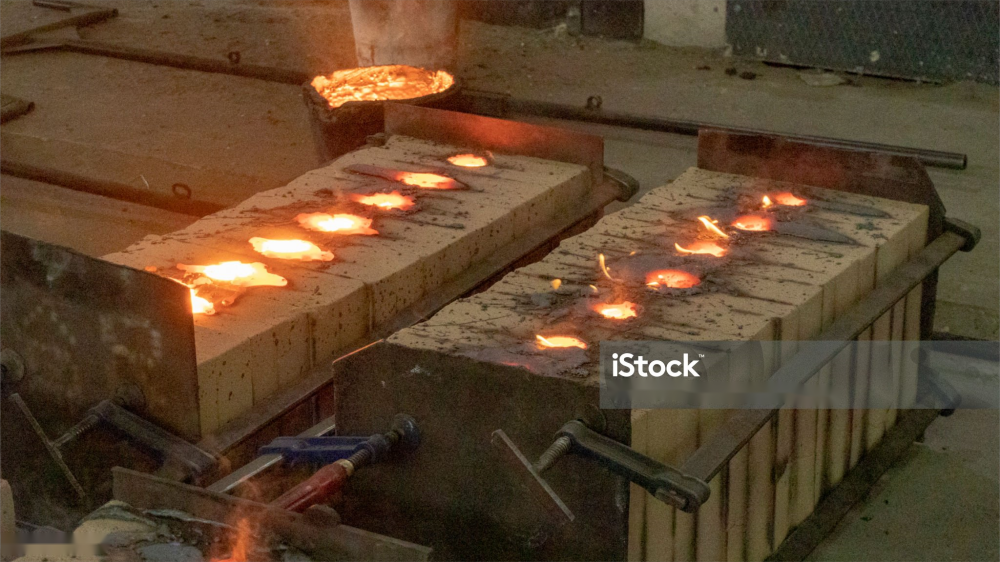What Metals Used in Sand Casting?

Sand casting is a versatile process suitable for producing a wide range of metal parts. Below is a more detailed look at the common metals used in sand casting, their characteristics, and typical applications.
Ferrous Metals
1. Gray Iron
Characteristics:
High carbon content gives it a characteristic gray appearance.
Good machinability due to the graphite flakes which act as chip breakers.
Excellent vibration damping properties.
Good wear resistance.
Applications:
Engine blocks, cylinder heads, and manifolds in automotive applications.
Machinery bases and housings.
Pipe fittings and valves.
2. Ductile Iron (Nodular Iron)
Characteristics:
Similar to gray iron but with spherical graphite inclusions, giving it higher strength and ductility.
Good impact and fatigue resistance.
Better mechanical properties compared to gray iron.
Applications:
Automotive components such as crankshafts and gearboxes.
Heavy-duty machinery parts.
Pressure-containing parts like pipes and pump housings.
3. Malleable Iron
Characteristics:
Heat-treated white cast iron that is more ductile and impact-resistant.
Combines good tensile strength with ductility.
Applications:
Small castings requiring good mechanical properties, such as brackets and levers.
Pipe fittings and hardware.
4. Steel
Characteristics:
High strength and durability.
Excellent wear and impact resistance.
Can be alloyed to enhance specific properties like corrosion resistance (e.g., stainless steel).
Applications:
Large structural components and machinery parts.
Mining equipment and heavy-duty tools.
Turbine blades and engine components in power generation.
Non-Ferrous Metals
1. Aluminum
Characteristics:
Lightweight and excellent corrosion resistance.
Good thermal and electrical conductivity.
Easily machinable and formable.
High strength-to-weight ratio.
Applications:
Automotive parts like engine blocks, cylinder heads, and transmission cases.
Aerospace components, including frames and structural parts.
Consumer products, such as cookware and sporting goods.
2. Brass
Characteristics:
Alloy of copper and zinc, known for its yellowish appearance.
Excellent corrosion resistance and machinability.
Attractive appearance and easy to polish.
Applications:
Plumbing fixtures and fittings.
Decorative hardware and musical instruments.
Valves, gears, and bearings.
3. Bronze
Characteristics:
Alloy of copper and tin, sometimes with other elements like phosphorus, manganese, aluminum, or silicon.
High wear resistance and low friction.
Good corrosion resistance, especially in marine environments.
Applications:
Bearings and bushings.
Marine hardware and ship propellers.
Statues, sculptures, and art pieces.
4. Copper
Characteristics:
Excellent electrical and thermal conductivity.
Good corrosion resistance, especially in moist environments.
Malleable and ductile.
Applications:
Electrical components such as connectors and terminals.
Heat exchangers and radiators.
Plumbing pipes and fittings.
5. Magnesium
Characteristics:
Very lightweight, the lightest of all structural metals.
Good strength-to-weight ratio.
Excellent machinability and dimensional stability.
Can be prone to corrosion without proper coating or alloying.
Applications:
Aerospace components, including structural frames and housings.
Automotive parts, such as transmission cases and engine blocks.
Consumer electronics casings and sporting equipment.
6. Zinc
Characteristics:
Good corrosion resistance and castability.
Lower melting point, making it easy to cast.
Excellent for creating complex shapes with thin walls.
Applications:
Automotive components, such as carburetors and fuel pumps.
Electrical fittings and connectors.
Hardware like locks, hinges, and decorative items.
Considerations for Choosing Metals in Sand Casting
Mechanical Properties:
Consider the required strength, hardness, ductility, and toughness for the application.
Corrosion Resistance:
Select metals based on their ability to withstand the operating environment, particularly for outdoor or marine applications.
Machinability:
Evaluate how easily the metal can be machined to achieve the desired tolerances and surface finishes.
Thermal Properties:
For applications involving heat, consider the metal's thermal conductivity and expansion characteristics.
Weight:
For applications where weight is a critical factor, such as in aerospace and automotive industries, lightweight metals like aluminum and magnesium are preferable.
Cost:
Factor in the material cost and the overall cost of processing and finishing the cast parts.
Summary
Sand casting is a highly adaptable manufacturing process used with a variety of metals to produce parts with diverse properties and applications. The choice of metal depends on specific requirements such as mechanical properties, corrosion resistance, machinability, thermal properties, weight, and cost. By carefully selecting the appropriate metal, manufacturers can ensure the final cast products meet the desired performance and quality standards.
Dongrun Casting have 20000 square meters facility houses and 200 production & test equipment, From quotation and tooling design to casting and finished machining, we can work with you at every stage. We serves wide range of industries-from Fortune 500 corporations to small and midsize OEMs. Our products includes: Automotive&Trucking, Electric Utility & Communications, Metering System, Hydraulic Industry, Medical Devices, Lighting, Fuel and Gas Pressure, Furniture parts.
More Details : www.dongruncasting.com
